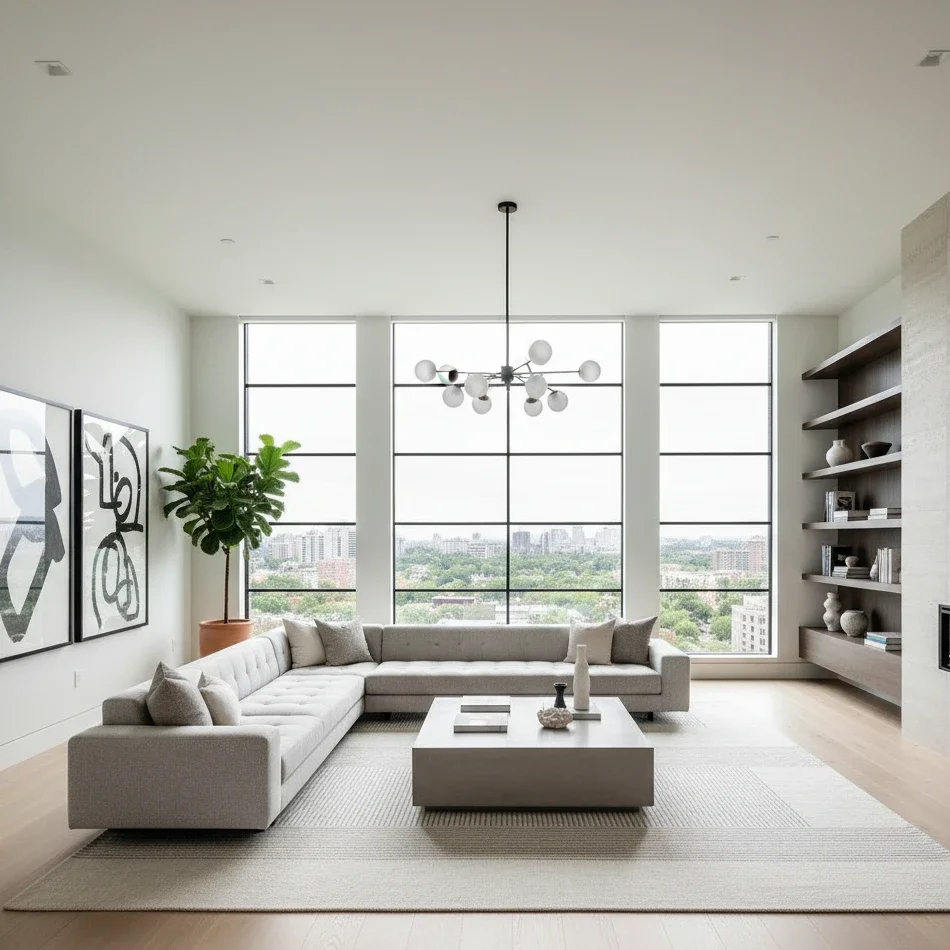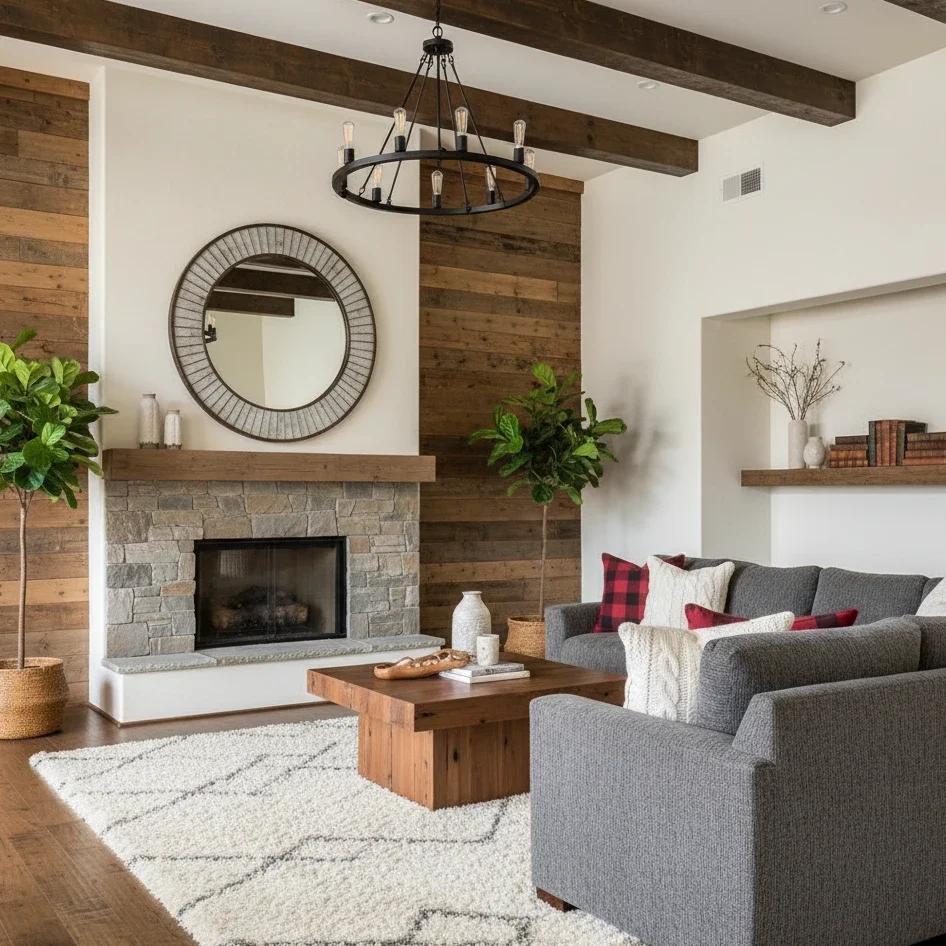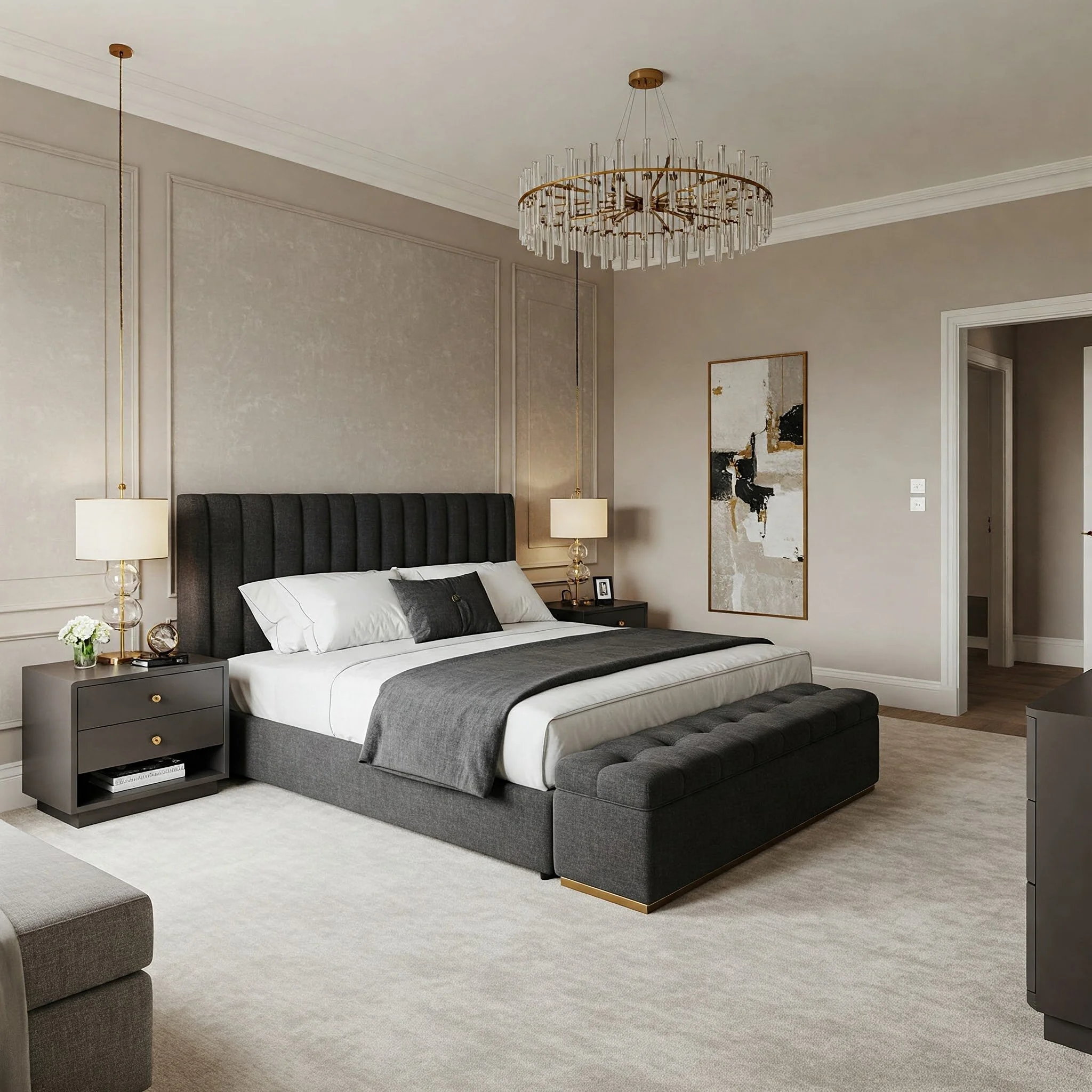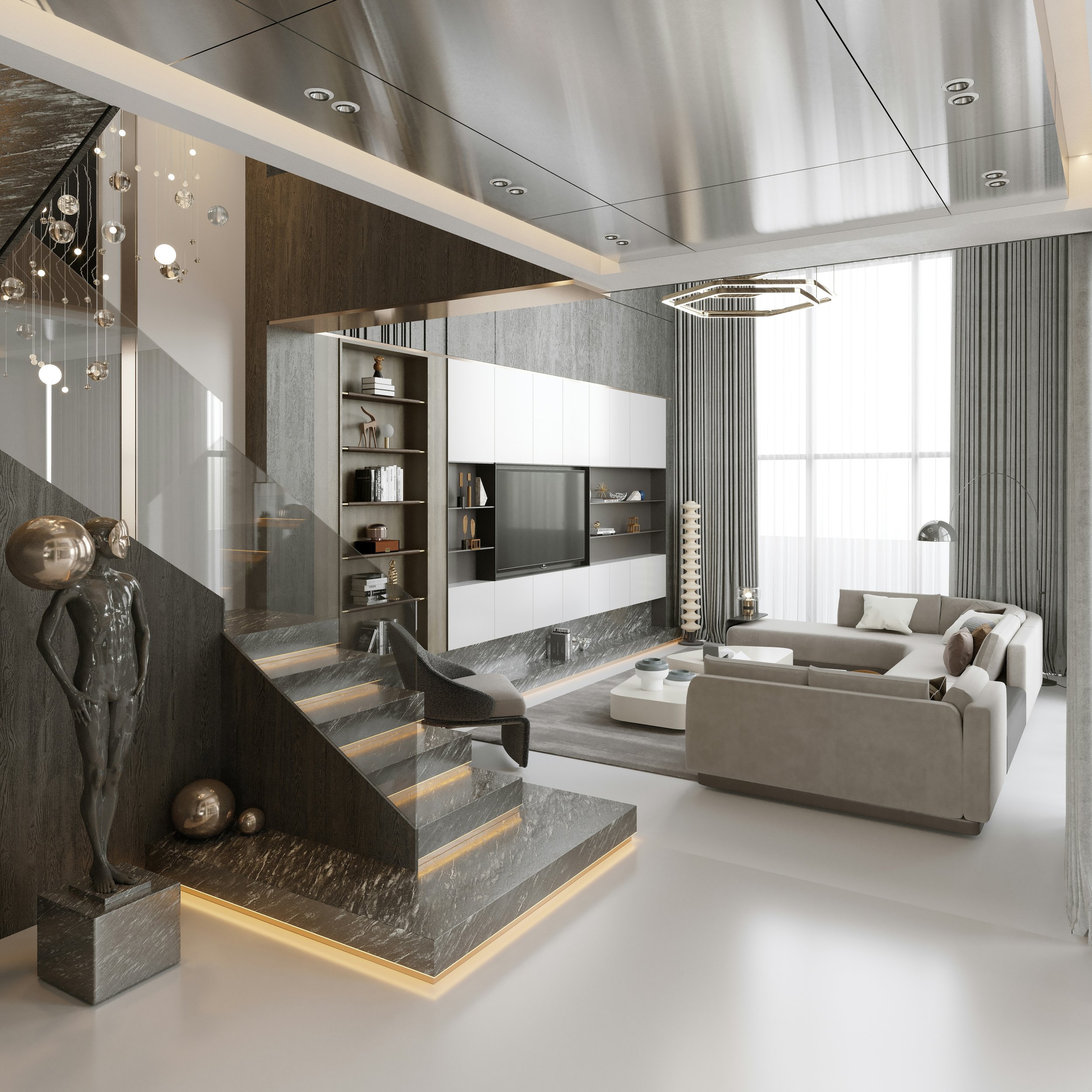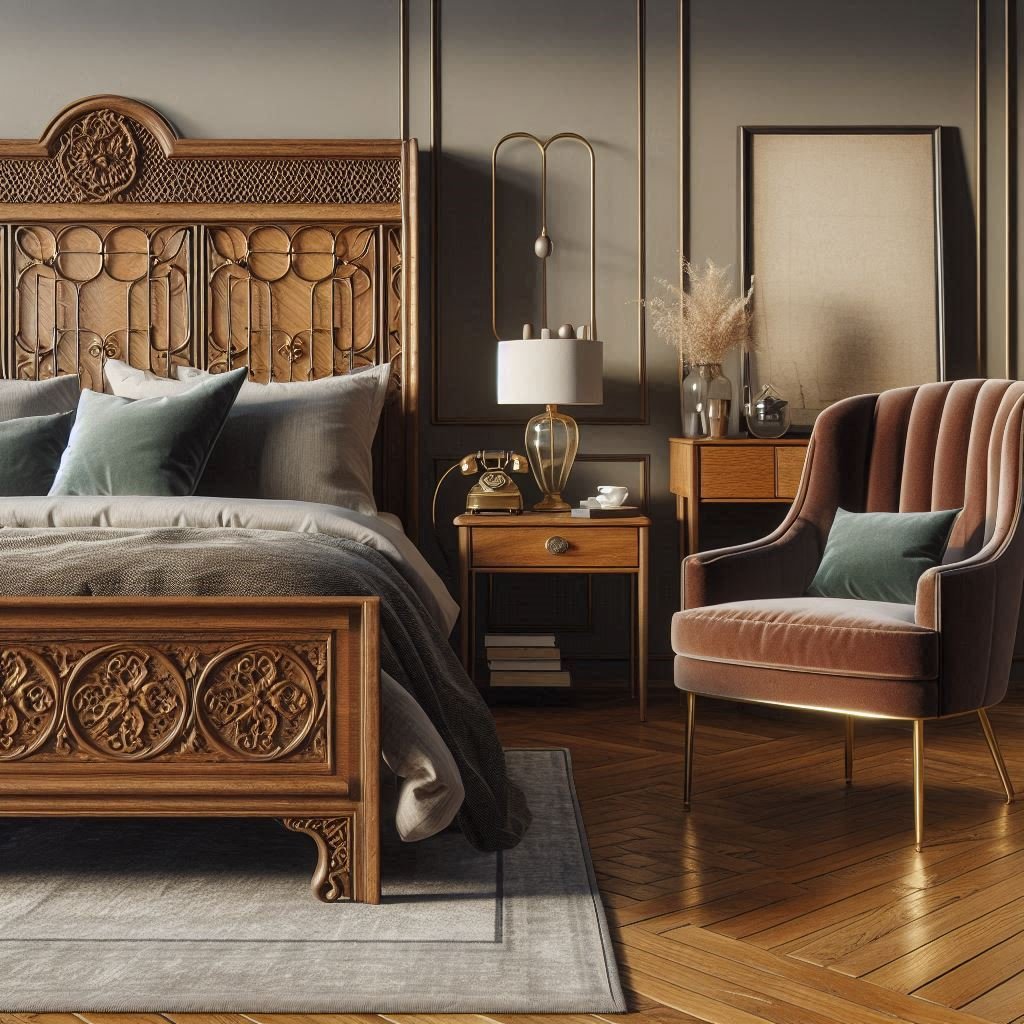Mixing Modern and Rustic: How to Balance Comfort With Clean Lines
Discover how to combine modern and rustic design elements to create a cozy yet sophisticated home that perfectly balances comfort and style.
To mix modern and rustic styles, you'll want to create a harmonious balance of clean lines and cozy textures. Start with a neutral color palette that softens modern sharpness while warming the space. Incorporate reclaimed wood alongside sleek metal accents for an inviting aesthetic. Choose multifunctional, comfortable furniture that aligns with your space's flow. Layer textiles like plush throws or velvet cushions to enhance comfort. Add greenery to breathe life into the design, grounding both styles. By thoughtfully combining these elements, you'll achieve a beautifully curated atmosphere that reflects your unique vibe, and there's so much more to explore.
Understanding Modern and Rustic Styles
In exploring the world of interior design, you'll find a fascinating interplay between modern and rustic styles. Modern characteristics often shine through clean lines, open spaces, and minimalistic approaches that evoke a sense of tranquility.
In contrast, rustic elements pull from nature, featuring raw materials like wood and stone, creating warmth and inviting comfort. Understanding these styles requires an appreciation of their design principles, which can merge to achieve aesthetic harmony.
As you consider style evolution, think about how cultural influences shape these designs. A spatial arrangement that incorporates both styles can create a dynamic atmosphere; imagine sleek furniture paired with a reclaimed wood dining table, highlighting the beauty of contrast.
Material choices play an essential role too—concrete and metal alongside organic fabrics can evoke emotional impact, making your space feel both contemporary and grounded.
Remember the historical context of each style as you blend them. This awareness allows you to appreciate their roots while creating a space that feels uniquely yours.
Choosing a Color Palette
Balancing modern and rustic elements in your space naturally leads to reflections on color, which play a pivotal role in uniting these styles. To create harmony, consider color psychology; your palette can evoke feelings of warmth and comfort or sophistication and calm.
Start with a foundation of neutral tones—think soft grays, beiges, or warm whites—that provide a clean backdrop for both modern and rustic pieces.
Incorporate seasonal palettes to keep your space feeling fresh and vibrant. For instance, embrace soft hues in spring and summer, while rich, vintage colors can bring coziness in the fall and winter. Accent colors—such as deep navy or rust—can introduce bold contrasts that energize the room.
You might also experiment with monochromatic schemes, creating depth through varying shades of a single color. This approach offers a serene backdrop, allowing rustic textures and modern lines to shine.
Ultimately, your color choices should reflect your personality and the freedom you seek in your space, blending comfort with clean lines in a way that feels uniquely yours.
Selecting Furniture Wisely
When selecting furniture, you want to mix and match pieces that bring out the best in both modern and rustic styles.
Start by exploring diverse furniture styles that blend clean lines with earthy textures. Look for multifunctional pieces, like a sleek coffee table that doubles as storage, allowing you to maximize space planning while keeping your environment uncluttered.
Consider your material choices carefully; reclaimed wood adds warmth, while metal accents provide a contemporary edge.
Focus on comfort factors, ensuring each piece invites relaxation. Don't shy away from sustainable options that not only reflect your values but also enhance your aesthetic.
Pay attention to ergonomics focus, especially if you're investing in seating. Your chair should cradle you, marrying function with style.
And, of course, keep budget considerations in mind. It's possible to find stunning furniture that doesn't break the bank—think second-hand shops or local artisans who create unique pieces. For those planning a bigger transition, working with Tulsa home buyers can also provide a practical option for moving forward quickly.
Integrating Textures and Materials
Combining various textures and materials can transform your space into a harmonious blend of modern sophistication and rustic charm. Imagine the warmth of reclaimed wood meeting the sleekness of polished metal. This juxtaposition creates inviting textural contrasts that draw the eye and invite touch.
You can incorporate plush textiles like velvet or wool to soften hard surfaces, enhancing comfort while maintaining a clean aesthetic.
Consider layering your materials thoughtfully. A smooth, glass coffee table atop a woven jute rug creates a compelling visual rhythm. You might also mix matte finishes with glossy ones to amplify material harmony; think of matte black accents against shiny brass fixtures.
Don't shy away from mixing different wood tones, either—this adds depth and richness to your design.
To keep things fresh, introduce natural elements like stone or ceramic. These organic materials can ground your space while enhancing the overall aesthetic.
Balancing Proportions and Scale
Achieving harmony in your space often hinges on understanding proportions and scale. When you blend modern and rustic elements, it's essential to create a sense of proportional harmony that promotes visual balance.
Think about how each piece interacts with the others, guaranteeing your eye flows smoothly throughout the room.
Consider these key aspects for effective design:
Furniture Arrangement: Choose a mix of oversized and understated pieces to create scale contrast, enhancing dimensionality.
Height Variation: Incorporate elements of varying heights—tall, sleek bookshelves paired with low, cozy seating create engaging layers.
Color and Texture: Use a cohesive color palette that ties together rustic warmth and modern sleekness, boosting design cohesion.
With spatial awareness, you can strategically place items to maintain balance. Avoid overcrowding and allow each piece to breathe.
Think about how the arrangement guides the eye and guarantees comfort while celebrating clean lines.
Lighting to Enhance Ambiance
Three key lighting elements can transform your space, enhancing the ambiance and perfectly blending modern and rustic design.
Start with ambient lighting to create a warm, inviting glow. Think about soft, diffused fixtures that allow natural light to spill in, fostering a serene atmosphere.
Next, layer your illumination with adjustable options. Incorporate dimmers and pendants to enhance versatility, letting you shift from vibrant social gatherings to cozy evenings.
Mix various fixture styles—industrial metal for a modern touch paired with rustic wood to ground the space.
Finally, consider statement pieces like oversized chandeliers or sculptural floor lamps that draw the eye and spark conversation. These not only serve as focal points but also elevate the room's aesthetic.
Don't forget about energy efficiency; LED bulbs can provide the same warmth as traditional lighting while reducing your energy bills.
Artwork and Decorative Accents
When you incorporate artwork and decorative accents into your design, you create a visual narrative that reflects your personality while harmonizing the modern with the rustic.
Thoughtful artwork placement and decorative layering can transform your space into a sanctuary of style and comfort, giving it that unique flair that feels effortlessly to you.
Consider these elements when curating your collection:
Bold statement pieces: A large, modern painting can act as a stunning focal point, drawing the eye and providing a contemporary contrast to rustic elements.
Eclectic decorative accents: Mix textures like woven baskets or aged wood frames with sleek metal sculptures to add depth and interest.
Personalized touches: Incorporate family photographs or travel souvenirs that evoke memories, bringing warmth and narrative to the room.
Aim for balance—too much modernity can feel cold, while excess rustic touches may overwhelm.
Incorporating Nature and Greenery
Incorporating nature and greenery into your space instantly breathes life into the design, creating a rejuvenating contrast to both modern and rustic elements.
Imagine lush indoor plants cascading from shelves or vibrant vertical gardens adorning your walls, inviting a sense of tranquility and freedom. This biophilic design approach not only enhances aesthetics but also promotes well-being.
Opt for natural materials like wood and stone to ground your greenery, seamlessly blending the outdoors with your interior.
Experiment with color psychology, choosing plant hues that evoke calm or energy, depending on the room's purpose. Seasonal arrangements of flowers or foliage can add a touch of freshness, keeping your space dynamic and engaging throughout the year.
Embrace sustainable choices by selecting low-maintenance plants that thrive indoors, allowing you to enjoy the beauty of nature without the stress of extensive plant care. And for homeowners looking to simplify life even further, options like sell my house fast in Pensacola with Greg Buys Houses can provide a smooth transition without the usual hassles of traditional sales.
Incorporating greenery isn't just about visuals; it's a lifestyle that encourages a connection to nature.
Creating Functional Spaces
Creating functional spaces blends practicality with aesthetic appeal, ensuring your home serves both form and function. To achieve this balance, focus on space efficiency, layout optimization, and adaptable spaces that cater to your lifestyle.
Embrace open floorplans that flow effortlessly, allowing for easy traffic flow while zoning areas for distinct purposes.
Consider incorporating:
Multifunctional furniture: Choose pieces that serve multiple purposes, like a coffee table with storage or a sofa bed for guests.
Smart storage solutions: Utilize built-ins or under-bed storage to keep your space clutter-free while maintaining a clean aesthetic.
Ergonomic design: Select furniture that supports comfort and wellness, ensuring your home feels inviting without sacrificing style.
Personalizing Your Design
Embracing personal touches in your design transforms a house into a home, reflecting your unique personality and style. Start by weaving in sentimental items that spark joy and evoke cherished memories.
Perhaps a family heirloom, like your grandmother's vintage lamp, can anchor a room, blending beautifully with modern decor.
Consider showcasing custom artwork that resonates with your passion or travels. A striking piece can become a conversation starter, showcasing your artistic taste while harmonizing with clean lines.
Don't shy away from unique finds—those treasures discovered in quaint shops or local markets add character and a story to your space.
Travel souvenirs hold the power to transport you back to memorable adventures. Display them elegantly on shelves or walls, allowing them to serve as daily reminders of your journeys.
Handcrafted pieces, whether it's a pottery bowl or a woven textile, introduce warmth and authenticity, bridging the gap between rustic charm and modern minimalism.
Conclusion
By blending modern sleekness with rustic charm, you create a harmonious oasis that feels both inviting and sophisticated. Picture a cozy nook where clean lines meet warm wood, and each piece tells a story. As you personalize your space, let nature weave through your design, wrapping it in serenity and life. Embrace this balance, and your home will not just be a place to live, but a canvas where comfort and elegance dance together in perfect harmony.





